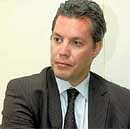
How is the CIE curriculum different from other Indian syllabi?
We pay a lot of attention to the student. The lesser the number in class, the better. It allows for holistic learning. About 25 per cent of test marks are alloted to knowledge. Application, analysis and understanding get 25 per cent each. This way, we believe, students understand subjects better.
What have you observed of Indian parents when it comes to their children’s academic performance?
Unlike in the UK or the West, parents play an integral role in a child’s learning process in
India. I have met parents who are always quizzing me on teaching methodologies, the amount of homework given to a child and marks allotted for assignments. What I have also noticed is the way most parents emphasise class marks. The marks card is sacred! And I’ve told them, ‘You should also be worried about their performance in the classroom, and not just the test paper’.
With CIE, are Indian students judged on the same platform as students in the UK and the West?
Of course, yes. The same course material is being passed around different countries. The idea behind this is to bring them all on a global platform, so that there is no disparity at a later stage when it comes to applying for universities etc. We’ve seen a phenomenal growth in India. Students here are constantly breaking old standards and records. This year, for example, we had 10 Indian students who topped the CIE Boards.
Spoonfeeding — that’s something Indian students and the education system have been accused of. What are your thoughts?
In the UK, you need to show that you’re a rounded individual. Universities there don’t care too much for marks or gold medals. And the only way to get there, I think, is to begin at the grassroot level with encouraging children to think on their own... allowing them the space to explore and find solutions to problems. The operative word is ‘independent learning’. It is essential for a child to be able to go through his course work and comprehend what is being written and told in class without the help of a teacher or a parent.
How have teachers coped with the CIE method?
Well, we started with a training programme where teachers from all schools congregated at one centre for two weeks and learnt teaching techniques and most importantly, rules on how to handle a textbook. Here’s something I often tell my teachers: It is a myth that the teacher has to be the know-all and end-all of everything. The reason for such emphasis is because we, at CIE, believe that a child should be allowed to question any information that is thrown his way. When a teacher is asked to clarify something and doesn’t have the answer, she/he tends to brush the child aside. Children should be allowed to see that teachers are human and that they may not know the answers to everything. That makes the teacher a more approachable and friendly face in the room.
Does the CIE curriculum encourage the use of technology in the classroom?
Here’s what we believe: Technology is a tool, use it when appropriate. Our curriculum is designed in such a way that it promotes reading and browsing. When students are asked to compile presentations or submit assignments, they are encouraged to write down the information that has been collected. The excessive use of computers does not make the child an independent learner. It only makes them dependent on technology. Besides, CIE is structured in such a way that we give English a lot of importance. Essay writing, letter writing and oral assessments are the different ways through which we make teaching more ‘hands-on’.
What is the classroom experience in CIE like?
In a typical classroom in a school that follows the CIE curriculum, we have a maximum of 30 students. Students are divided into teams, irrespective of the subject being taught. This way, children understand the concept of team effort. Assignments and homework are usually handled by child alone, and the text book is not the villain! In fact, teachers try and move away from the textbook, bring in life from outside into the classroom, and encourage social dialogue.
What about vocational training?
We leave that to the school. It’s their choice to include that in the syllabus. As is with case of extra curricular activities. It is up to the school to include activities like dance, music or creative arts into the syllabus.
Deccan Herald is on WhatsApp Channels| Join now for Breaking News & Editor's Picks